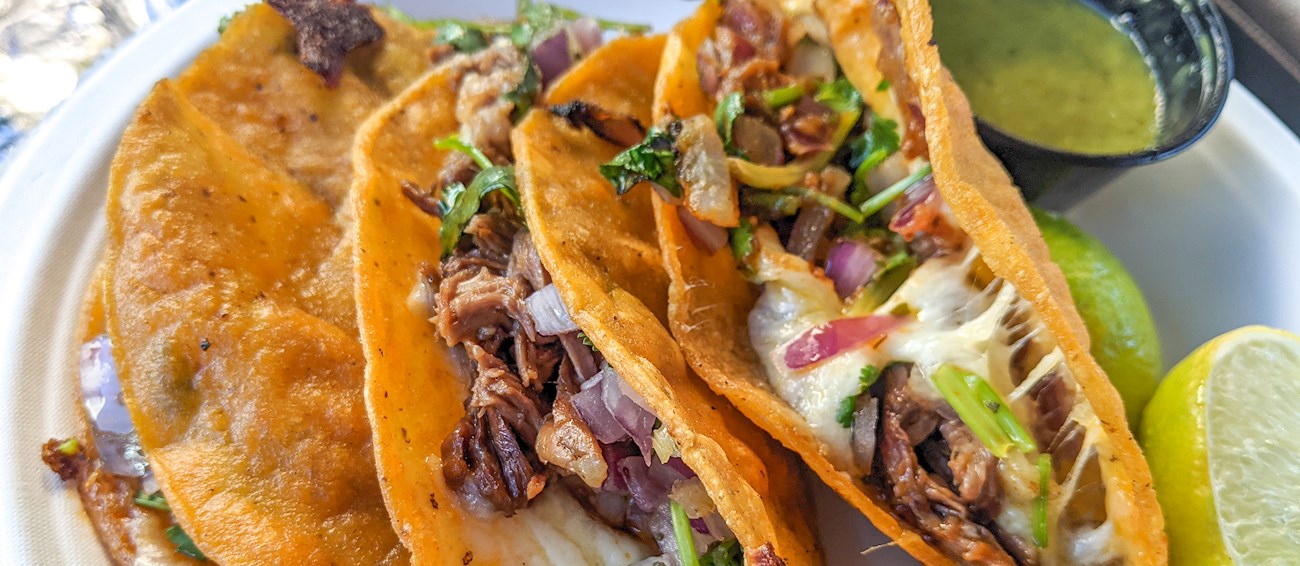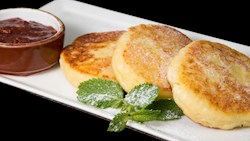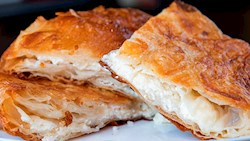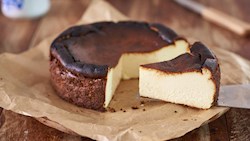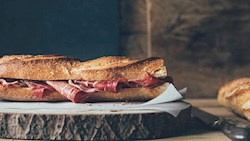Kahvaltı refers to breakfast in Turkish, and it's an essential and often lavish meal in Turkish culture. The word "kahvaltı" is derived from two words: "kahve" (coffee) and "altı" (under/before), which translates to "before coffee." It's a meal that traditionally happens before coffee is consumed, as in the Ottoman times, coffee was considered a beverage to be enjoyed after meals rather than during or before them.
Traditional Turkish kahvaltı showcases an expansive array of dishes, typically blending a multitude of flavors, textures, and food categories. The table is adorned with both sweet and savory items, spanning cheeses, olives, vegetables, local breads, eggs, börek, baklava or other sweet pastries, and more, accompanied by hot beverages such as Turkish tea (çay).
Quesabirria is a popular Mexican street food dish, a fusion between birria (a traditional Mexican meat stew) and quesadillas. The dish originates from Tijuana and typically consists of large tortillas filled with birria-style cooked meat (usually beef) and a generous amount of melted cheese.
The tortillas are cooked on the stove until the cheese melts and the outside of the tortilla becomes crispy. Quesabirria is often accompanied by a side of broth, or consomé, for dipping, adding another layer of flavor to the dish.
Belmuž is a traditional shepherd's dish originating from eastern Serbia. This simple dish consists of only three ingredients – cheese, flour, and a bit of salt. The key ingredient is cheese, that should be fresh and full-fat cow's or preferably sheep's cheese.
Once cut into pieces, the cheese is placed in a big pot over low heat. As it melts, salt and flour are added until a homogenous mass is formed. The mixture is continuously stirred with a big wooden spoon until the fat separates and starts to float on the surface.
MAIN INGREDIENTS
Pan de bono is a traditional bread consisting of cassava starch, cornmeal or corn flour, queso fresco, eggs, and sugar. The bread is shaped into bagels or balls that are slightly larger than golf balls. Pan de bono is similar to other South American cheese breads like pan de queso, difference being added conr flour or cornmeal, and a hint of sweeteness due to the addition of sugar.
It is usually served warm with a cup of hot chocolate on the side. Some claim that the name pan de bono was created after an Italian baker in Cali who used to yell pane del buono (good bread), while others say that it is named after a place called Hacienda El Bono, where it was first made.
MAIN INGREDIENTS
Antakya künefesi is a traditional kunāfah variety hailing from the ancient Turkish city of Antakya, made from shredded phyllo pastry filled with creamy unsalted cheese. The origins of this dish can be traced back to the Ottoman Empire, and to this day, it has remained one of the authentic representatives of Antakyan culinary heritage and traditions.
To make Antakya künefesi, the pastry is first prepared by shredding phyllo dough into thin strips and placing it into a flat, round tray. The dough, in this form known as kadayıfın, is then topped with a mixture of unsalted cheese, traditionally Hatay peyniri, and another layer of shredded phyllo dough.
MAIN INGREDIENTS
Translated as honey pie, this light Greek dessert is traditionally associated with the island of Sifnos, but its varieties can be found in other Greek regions as well. The pie combines fresh cheese, preferably mizithra based on sheep or goat milk, eggs, and honey, and it is usually baked as a round, crustless cake.
It is recommended to garnish melopita with a sprinkle of cinnamon and an additional drizzle of honey.
MAIN INGREDIENTS
Even though tiramisù is actually a fairly recent invention, this dessert of coffee-soaked ladyfingers layered with mascarpone cream enjoys an iconic status among Italian desserts. Its name stems from the phrase tirami sù, an Italian expression which literally means pick me up, a reference to the uplifting effects of sugar, liquor, and coffee.
The origins of tiramisù are heavily disputed between Veneto and Friuli-Venezia Giulia regions, but it is often suggested that the first was made in Veneto in the early 1960s. The earliest documented recipe for tiramisù (interestingly, without alcohol!) was printed in the 1981 spring edition of Vin Veneto magazine in an article on coffee-based desserts by Giuseppe Maffioli, a renowned food critic and member of the Italian Academy of Cuisine.
MOST ICONIC Tiramisù
View moreMAIN INGREDIENTS
Originating from the historical region of Red Ruthenia, these soft, crescent-shaped dumplings are filled with a combination of potatoes and cheese, which is occasionally modified with various seasonings or fried onions. Pierogi ruskie are usually boiled and shortly fried until they develop a crispy texture.
The dumplings are often served sprinkled with cracklings, crispy fried onions, or bacon, and can be enjoyed as a hearty appetizer or as a main course. In Ukraine, the pierogis are called varenyky, and they are so popular that there is even a monument celebrating varenyky in the city of Cherkasy.
MOST ICONIC Varenyky
View moreFound throughout southern Italy, parmigiana di melanzane is a type of gratinated vegetable casserole traditionally made of fried or grilled slices of eggplant layered with basil-flavored tomato sauce and topped with one or more cheeses, such as mozzarella, pecorino Siciliano, scamorza, and caciocavallo Silano.
Contrary to popular belief, parmigiana has nothing to do with parmigiano Reggiano cheese, even though it is used in many recipes as it makes for a crunchier crust. Nor, in fact, does it have any connection with the city of Parma whatsoever. In fact, the name of this scrumptious summer dish supposedly stems from parmisciana, the word for “Persian” in the Sicilian dialect, and it is often suggested that the word is rooted in the Arabic badhnajan or Turkish patlıcan, both of which mean “eggplant”.
VARIATIONS OF Parmigiana
MOST ICONIC Parmigiana
View moreThese stuffed dumplings derived their name from the Polish word for filled dumpling: pieróg. This former peasant food evolved into one of Poland's favorite dishes. Every family has their own version of pierogi filling, and the ingredients that can be used are limited only by the imagination of the chef.
Pierogi can be sweet, savory, or spicy, and the most common fillings include cheese, onions, ground meat, mushrooms, potatoes, and sauerkraut. The sweet versions commonly include various berries, such as strawberries or blueberries. Traditionally, these dumplings are served as the 12th course of a traditional Polish Christmas Eve dinner.
VARIATIONS OF Pierogi
MOST ICONIC Pierogi
View moreTasteAtlas food rankings are based on the ratings of the TasteAtlas audience, with a series of mechanisms that recognize real users and that ignore bot, nationalist or local patriotic ratings, and give additional value to the ratings of users that the system recognizes as knowledgeable. For the “100 Best Rated Dishes With Cheese” list until March 27, 2025, 807,765 ratings were recorded, of which 526,117 were recognized by the system as legitimate. TasteAtlas Rankings should not be seen as the final global conclusion about food. Their purpose is to promote excellent local foods, instill pride in traditional dishes, and arouse curiosity about dishes you haven’t tried.
